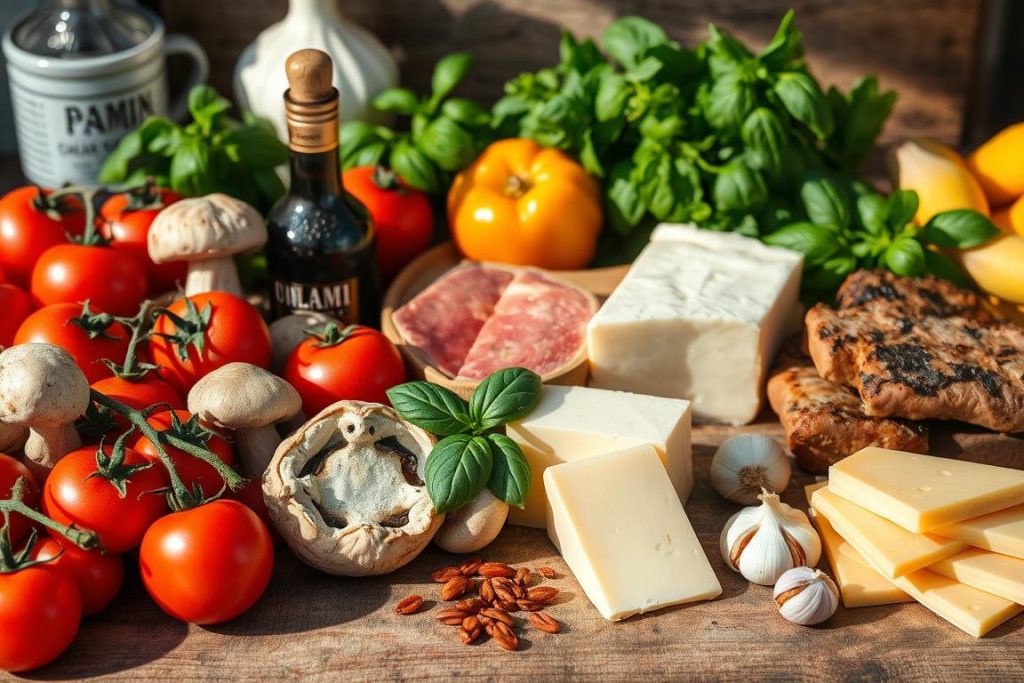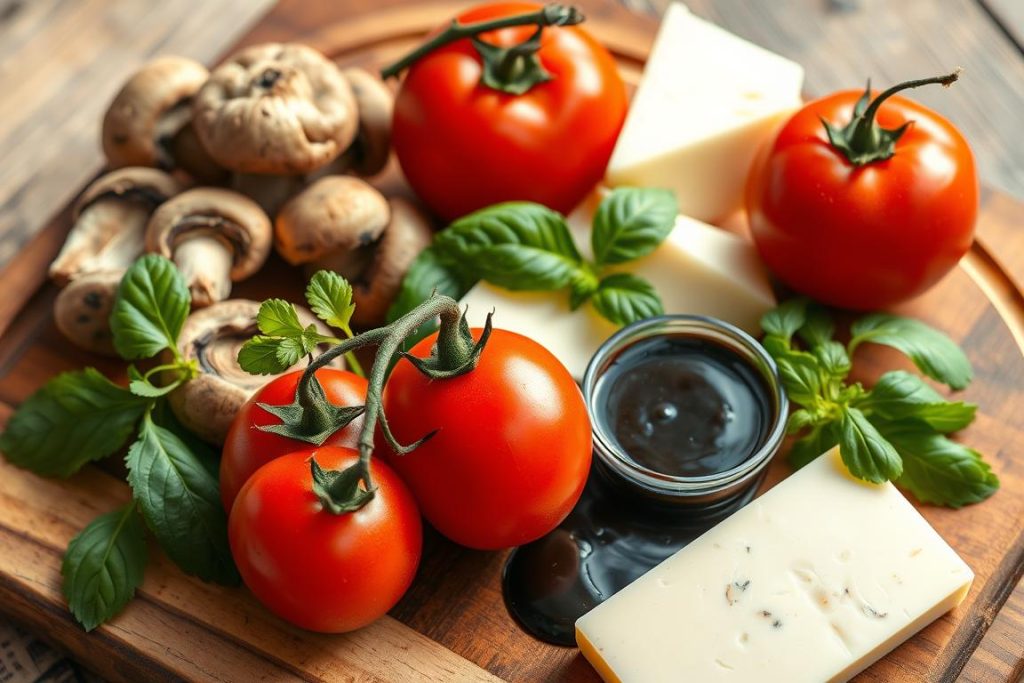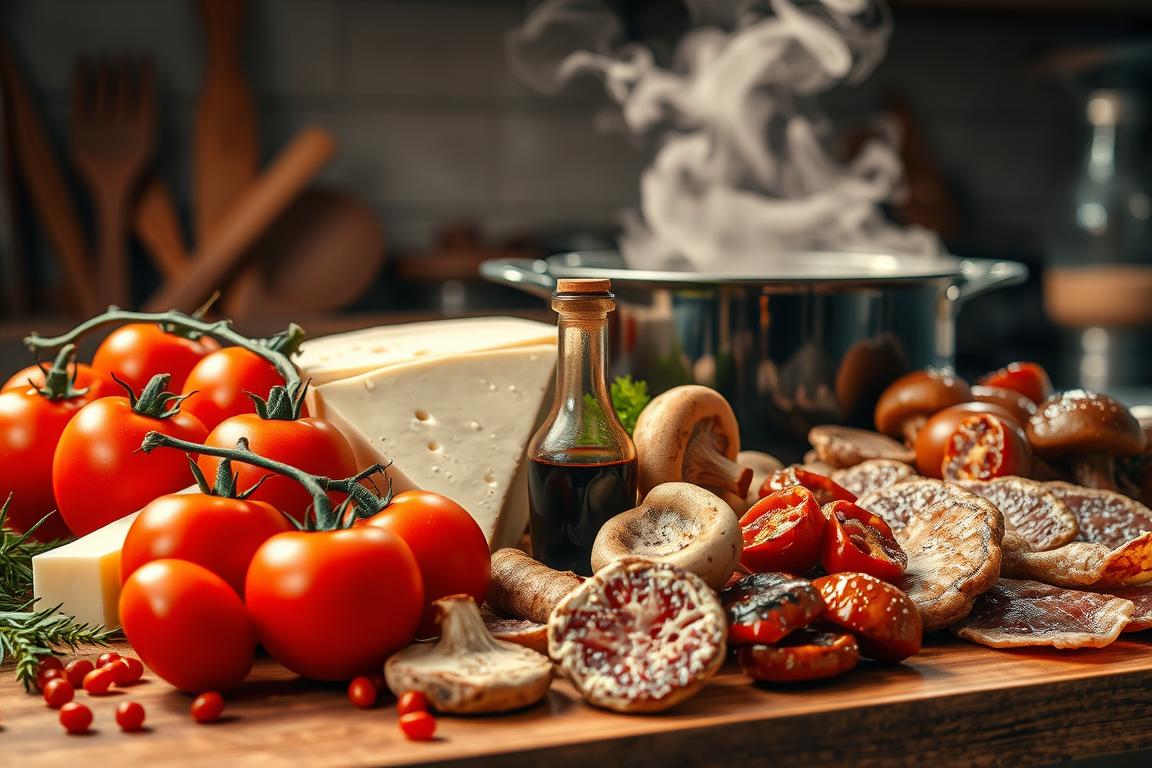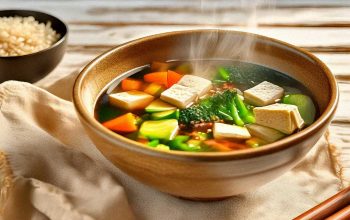Discover the secret to making dishes truly delicious by learning about umami, the fifth taste. It adds a savory depth that can make even simple meals special. In this guide, we’ll explore the science of umami, its importance in world cuisines, and how to enhance it in your cooking.
Umami is known as the “savory” taste and is found in many foods, like aged cheeses and slow-cooked meats. By grasping the basics of umami and how it works with other tastes, you’ll open up new culinary possibilities. This article is for both experienced cooks and food lovers, aiming to help you create meals that are full of flavor.
Understanding Umami: The Fifth Taste
In the world of cooking, umami has become very popular. It’s called the “fifth taste” and adds a savory flavor to food. This section explores the history, science, and sources of umami, helping us understand this unique taste.
What is Umami?
In 1908, Japanese scientist Kikunae Ikeda discovered umami. He found that glutamic acid in seaweed broth was responsible for its savory taste. Ikeda named it “umami,” meaning “delicious” in Japanese. Today, umami is one of the five basic tastes, along with sweet, sour, bitter, and salty.
The Science Behind Umami
Umami works through our taste receptors and certain molecules. Glutamic acid and MSG bind to taste buds, creating the umami sensation. Other compounds like inosinate and guanylate in meat and fish also enhance umami.
Common Sources of Umami
- Aged Cheeses: Parmesan, Roquefort, and other aged cheeses are full of glutamic acid, making them umami-rich.
- Mushrooms: Mushrooms, especially dried ones like porcini and shiitake, are high in glutamate, giving them a strong umami flavor.
- Tomatoes: Ripe tomatoes have glutamic acid and ribonucleotides, enhancing their umami.
- Soy Sauce: Soy sauce’s fermentation process creates umami-rich amino acids and peptides.
- Meat and Seafood: Proteins in meats, fish, and shellfish, like glutamine and inosinate, add to their umami flavor.
Knowing about umami and its sources helps both home cooks and chefs. It lets them make dishes that are more flavorful and satisfying.
The Role of Umami in Global Cuisines
Umami, the fifth taste, is key in many global cuisines. It adds rich, savory flavors to dishes. This taste is found in Asian cooking and Italian cuisine, making dishes more complex and satisfying.
Umami in Asian Cooking
In Asian cooking, umami is a flavor cornerstone. Soy sauce, fermented pastes, mushrooms, and aged cheeses are used for their umami. Dishes like Japanese miso soup and Korean bulgogi show umami’s depth.
Italian Cuisine and Umami
Italian cuisine also values umami. Aged Parmesan, cured meats, and slow-cooked tomato sauces are umami-rich. These ingredients add to the flavor profile of dishes like ragu and pesto.
The Influence of Umami in American Dishes
In America, umami appreciation is growing. Chefs and home cooks use umami-rich ingredients like mushrooms and soy sauce. This is changing American cooking, adding depth to burgers and vegetarian dishes.
| Cuisine | Umami-Rich Ingredients | Example Dishes |
|---|---|---|
| Asian | Soy sauce, miso, mushrooms, aged cheeses | Miso soup, bulgogi, braised meats |
| Italian | Parmesan, cured meats, tomato sauces | Ragu, pesto |
| American | Mushrooms, soy sauce, fermented condiments | Umami burgers, savory vegetarian dishes |
“Umami is the secret to unlocking the true depth of flavor in a wide range of global culinary traditions.”
Identifying Umami-Rich Ingredients
Learning about umami-rich ingredients can take your cooking to new heights. Fermented foods, meats, and seafood are full of umami. Knowing about these can change how you cook.
Fermented Foods as Umami Powerhouses
Foods like soy sauce, miso, and aged cheeses are umami goldmines. Fermentation breaks down proteins into amino acids. This releases umami compounds, giving these foods their deep flavors. Adding fermented foods to your cooking can boost umami.
The Umami Profile of Meats and Seafood
Aged beef, anchovies, and other meats and seafood are key to umami. Aging concentrates glutamates, making them savory and delicious. Try different cuts and preparations to find your favorites.
Vegetables That Pack a Umami Punch
- Tomatoes: These juicy fruits are full of natural MSG, adding umami flavor.
- Mushrooms: Fresh or dried, mushrooms are glutamate-rich, making them umami powerhouses.
- Seaweed: Kelp, nori, and other sea vegetables are full of inosinate and guanylate, boosting umami.
Understanding umami-rich ingredients opens a world of flavor. Experiment with these foods to enhance your cooking. You’ll satisfy your cravings for savory flavors.
Techniques to Enhance Umami in Cooking
Boosting the umami in your dishes can change the game in the kitchen. There are many ways to do this, from roasting and grilling to fermentation. Let’s dive into some practical methods to elevate your cooking to umami-rich levels.
Roasting and Grilling for Flavor Amplification
Roasting and grilling can intensify umami flavors. The Maillard reaction, happening when foods are heated intensely, creates new flavors. Roasting veggies, meats, and fruits can reveal a world of savory umami flavors.
The Art of Fermentation in Home Cooking
Fermentation is a traditional method that boosts umami in cooking. Foods like soy sauce, miso, aged cheeses, and cured meats are full of umami. Trying homemade fermentation can add more umami to your meals.
Balancing Umami with Other Flavors
Umami is powerful, but it needs balance with other flavors. Mixing umami with sweetness, acidity, or bitterness creates a rich taste experience. Learning to balance umami will help you make dishes that wow your taste buds.
| Technique | Benefits | Best Umami-Rich Ingredients |
|---|---|---|
| Roasting and Grilling | Intensifies savory notes through Maillard reaction | Meats, vegetables, certain fruits |
| Fermentation | Unlocks umami-rich compounds in foods | Soy sauce, miso, aged cheeses, cured meats |
| Balancing Flavors | Harmonizes umami with other taste profiles | Sweet, acidic, and bitter ingredients |
“The key to enhancing umami in your cooking is to embrace a variety of techniques that unlock the savory depth of your ingredients.”
Cooking Methods that Boost Umami
Choosing the right cooking methods can really enhance your dishes’ savory flavors. From slow simmering to high-heat techniques, different methods can bring out the umami notes. These notes make your meals more enjoyable.
Slow Cooking for Deep Flavor Development
Slow cooking, like braising or stewing, is great for rich flavors. It lets complex aromas develop and breaks down tough parts of food. This makes dishes like beef bourguignon and coq au vin incredibly flavorful.
The Impact of Temperature on Umami Extraction
- High heat: Grilling, roasting, and searing at high temperatures can caramelize sugars and proteins, unleashing an explosion of umami flavors.
- Low heat: Gentle simmering or slow-cooking at lower temperatures helps gradually extract umami compounds from ingredients, resulting in a more nuanced, balanced flavor profile.
Knowing how temperature affects umami is crucial. Finding the right balance between high and low heat can enhance savory flavors.
Using High Heat to Create Complex Flavors
For intense umami, high-heat methods like grilling and searing work well. The Maillard reaction, happening when foods are heated intensely, creates complex flavors. This is great for meats, seafood, and some veggies, bringing out their umami.
| Cooking Method | Impact on Umami |
|---|---|
| Slow Cooking | Develops deep, complex flavors by breaking down proteins and allowing aromatic compounds to concentrate |
| High Heat | Caramelizes sugars and proteins, creating an explosion of umami notes through the Maillard reaction |
| Low Heat | Gently extracts umami compounds, resulting in a more nuanced, balanced flavor profile |
By understanding cooking temperatures and techniques, you can enhance your dishes’ savory flavors. This makes your meals more exciting and satisfying.
Combining Umami with Other Taste Profiles
In the world of cooking, finding the right mix of flavors is an art. Umami, the savory fifth taste, is key to this. It works well with sweet, acidic, and bitter flavors to make dishes stand out.
Sweet and Umami: A Perfect Pairing
Sweet and umami flavors go hand in hand in many cuisines. Sweet ingredients like caramelized onions and roasted meats enhance umami’s depth. This mix is seen in teriyaki chicken, braised beef, and even desserts.
Balancing Umami with Acidic Ingredients
Umami gives a savory base, but adding acidity cuts through richness. Citrus, vinegars, and fermented foods like soy sauce add a refreshing touch. This balance is crucial for dishes that highlight umami.
The Harmony of Umami and Bitter Flavors
Umami and bitter flavors create interesting combinations. Umami’s earthy taste pairs well with dark chocolate and roasted coffee. When balanced, this mix makes dishes complex and exciting.

Understanding how umami interacts with other flavors opens up new possibilities. By experimenting with these combinations, you can create dishes that truly showcase umami’s beauty.
The Importance of Seasoning for Umami Enhancement
Seasoning is key to bringing out umami flavors in your food. Salt and aromatic spices are essential. They add depth and complexity to umami.
Salt: The Essential Component
Salt is at the heart of great seasoning. It boosts the taste enhancer and natural flavors of umami-rich foods. Balancing salt levels enhances umami and creates a balanced flavor.
Layering Flavors with Spices
Spices add to the umami experience. Garlic, onion, and mushroom powder add depth. Earthy spices like cumin and chili pepper complement umami.
Using Stocks and Broths for Depth
Stocks and broths are great for umami. They’re full of glutamates and nucleotides. Adding them to your dishes gives a savory base that enhances umami.
Mastering seasoning unlocks umami’s full potential. Salt, spices, and stocks are the keys. They bring out the depth and complexity of umami flavors.
Umami in Vegetarian and Vegan Cooking
In vegetarian and vegan cooking, umami is key to making plant-based dishes taste great. Glutamic acid, the umami compound, is often found in animal products. But, there are many plant-based sources of umami that can make meals rich and satisfying.
Plant-Based Sources of Umami
- Mushrooms, especially dried porcini, portobello, and shiitake, are potent sources of glutamic acid.
- Fermented soy products like miso, tamari, and tempeh are rich in naturally occurring natural flavors.
- Certain seaweeds, such as kombu and nori, contain high levels of plant-based umami.
- Tomatoes, particularly when roasted or sun-dried, unlock their inherent umami potential.
- Nuts and seeds, like walnuts, almonds, and pumpkin seeds, can contribute to the umami profile of vegan dishes.
Creative Umami-Rich Vegan Dishes
Using these plant-based umami sources, chefs and home cooks can make many tasty vegan dishes. Imagine a savory mushroom-based risotto, a hearty miso-glazed tofu stir-fry, or a seaweed-infused vegetable broth. The options are endless when you know how to use plant-based ingredients for umami.
Enhancing Flavors Without Animal Products
To add umami to vegetarian and vegan dishes, it’s important to understand these natural flavors. You can slow-roast vegetables or try fermented foods to boost umami in plant-based meals.
By exploring plant-based umami, vegetarian and vegan cooks can make dishes that are not only healthy but also full of flavor. Learning to use umami in meat-free cooking opens up a world of tasty possibilities for those who love to cook.
Umami and Health Benefits
Umami’s health benefits are quite interesting. It’s the fifth basic taste, linked to glutamic acid in foods. MSG is a pure form of this acid, key to umami flavors.
Nutritional Aspects of Umami-rich Foods
Foods high in umami, like mushrooms and aged cheeses, are packed with nutrients. They have vitamins, minerals, and antioxidants that boost health. For instance, glutamic acid can improve brain function and mood.
The Effects of Umami on Satiety
Umami flavors affect our feeling of fullness. Studies show umami foods can release hormones that tell the brain we’re full. This can lead to feeling more satisfied and help with weight control.
How Umami Affects Your Taste Buds
Umami works differently with our taste receptors. The glutamic acid in these foods binds to specific receptors on the tongue. This signals the brain for a savory taste, making meals more enjoyable.
| Umami-Rich Ingredient | Nutritional Benefits |
|---|---|
| Mushrooms | High in vitamin D, selenium, and antioxidants |
| Aged Cheeses | Rich in protein, calcium, and beneficial bacteria |
| Fermented Sauces | Contain probiotics and enzymes that support gut health |

“Umami is the secret to creating deeply satisfying, flavorful dishes. Understanding its nutritional benefits can help us make more informed choices in the kitchen.”
Pairing Umami Ingredients with Wine
Pairing umami-rich ingredients with the right wine is like a symphony. Umami, the savory fifth taste, can be enhanced by the right wine. This creates a world of flavor possibilities.
Best Wines to Complement Umami Flavors
For dishes with bold umami, choose full-bodied red wines. Cabernet Sauvignon, Malbec, and Merlot work well. They have tannins and dark fruit flavors that match umami’s intensity.
For a lighter touch, try crisp white wines. Sauvignon Blanc or Albariño can offer a refreshing contrast to umami’s richness.
The Role of Tannins in Umami Pairings
Tannins in wine are key in umami pairings. They balance the savory, sometimes heavy taste of umami. Choosing wines with the right tannins is crucial for a perfect balance.
Crafting the Perfect Umami Wine List
Creating a wine list for umami dishes needs careful thought. Offer a variety of wines, from light to bold. This way, you can match different umami flavors.
Adding lighter, more acidic wines can balance the experience. This gives guests a well-rounded selection.
| Wine Variety | Umami Pairing Recommendation |
|---|---|
| Cabernet Sauvignon | Grilled meats, mushroom dishes, aged cheeses |
| Sauvignon Blanc | Seafood, soy-based sauces, roasted vegetables |
| Malbec | Braised beef, umami-rich stews, cured meats |
| Albariño | Sushi, fresh salads, light seafood dishes |
Understanding umami and wine pairing can elevate your dishes. It offers guests an exceptional dining experience. Discover the perfect wine pairings for your umami creations.
Experimenting with Umami Flavor Combinations
The world of cooking is fascinated by umami’s savory taste. It’s the fifth basic taste, opening up endless flavor adventures. We’ll explore making umami-rich sauces, creating fusion dishes, and layering umami flavors in complex recipes.
Creating Umami-Rich Sauces and Condiments
Sauces and condiments are great for showing off umami’s versatility. Use ingredients like fermented soy sauce, miso, Parmesan cheese, or mushrooms. These can make your sauces taste amazing, adding depth to any dish.
Try mixing different umami-rich elements to make unique flavors. For example, a savory-sweet teriyaki sauce or a robust umami-infused ketchup can be a hit.
The Art of Umami-based Fusion Dishes
Umami can bring together flavors from different cuisines, making fusion dishes. Mix Asian, Mediterranean, and American flavors with umami ingredients like soy sauce, anchovies, and Worcestershire sauce. This creates dishes with exciting umami combinations.
Building Layered Umami in Complex Recipes
For those who love umami, making complex recipes is a challenge. Layer umami-rich elements in your dishes for a symphony of flavors. Use slow-cooked meats, caramelized vegetables, fermented condiments, and savory broths. Each adds to the umami taste.
Unlocking umami’s full potential means experimenting and exploring. Dive into umami flavor combinations and let your creativity shine.
Understanding Umami in Modern Gastronomy
Umami has become a key player in the world of food. It’s the fifth taste, known for its savory and complex flavors. This has led to new techniques and creative approaches in cooking.
Molecular Gastronomy and Umami
Molecular gastronomy has opened up new ways to explore umami. Chefs use science to extract and concentrate glutamic acid, the core of umami. This has changed how we experience umami in our food.
Chef Techniques for Amplifying Umami
- Fermentation: Chefs use fermentation to add depth to umami dishes. Aging, curing, and using koji can unlock an ingredient’s full potential.
- Maillard Reaction: Cooking proteins and sugars at high heat enhances umami flavors.
- Umami-rich Broths and Sauces: Stocks, bone broths, and savory sauces are the base for umami dishes.
The Future of Umami in Culinary Innovation
Umami’s role in future cooking is clear. Chefs are mixing umami with other flavors to create new tastes. This includes umami-rich plant-based dishes and using glutamic acid in molecular cooking.
| Technique | Description | Umami Enhancement |
|---|---|---|
| Fermentation | Harnessing the power of microbial processes to create depth and complexity of flavors | Fermentation unlocks the hidden umami potential of ingredients through the breakdown of proteins |
| Maillard Reaction | The chemical reaction between amino acids and reducing sugars that occurs during high-heat cooking | The browning and caramelization of proteins and sugars can significantly boost umami notes |
| Umami-rich Broths and Sauces | Slow-simmered stocks, bone broths, and savory sauces that serve as the foundation for umami-driven dishes | These liquid umami powerhouses provide a concentrated base for amplifying the fifth taste |
Common Mistakes When Cooking with Umami
Learning to cook with umami can make your dishes amazing. But, it’s key to avoid common mistakes that can mess up the flavor. These mistakes include using too much umami or low-quality ingredients. Knowing these can help you get the perfect umami taste in your food.
Overdoing Umami and Its Effects
Umami is a strong flavor enhancer, but too much can be bad. Too much MSG, soy sauce, or other umami sources can make your food taste harsh and unbalanced. It’s important to use these ingredients wisely. They should enhance the flavor, not take over.
Misunderstanding Flavor Balance
Getting the right umami balance is more than just using the right amount of ingredients. It’s also about how these ingredients work with other flavors. If you don’t balance sweet, sour, salty, and bitter, umami can be too much. Try different amounts and layering to find the perfect balance.
Avoiding Low-Quality Umami Sources
- Not all umami-enhancing ingredients are the same. Cheap MSG or soy sauce can add bad flavors and even harmful stuff to your food.
- Look for high-quality, natural umami sources like fermented foods, aged cheeses, and fresh meats and seafood. These will give your dishes a better umami taste.
By knowing and avoiding these common mistakes, you can really use umami to its fullest in your cooking. With an eye for balance and using top-notch umami ingredients, you’ll get better at cooking with the fifth taste.
Recipes That Emphasize Umami
Discover the rich flavors of umami in our collection of recipes. We have both classic dishes and new creations. These recipes will make your cooking better and your taste buds happy.
Classic Umami-Rich Dishes to Try
- Beef Teriyaki: Tender beef in a rich teriyaki sauce, served with white rice.
- Spaghetti Carbonara: A creamy sauce with egg yolks, Parmesan, and pancetta, a Roman favorite.
- Miso Soup: A Japanese classic, warm and full of fermented soybean paste flavors.
Unique Recipes to Highlight Umami Flavor
Try these creative ways to add umami to your meals:
- Portobello Mushroom Burgers: Grilled mushrooms with a savory marinade, a tasty veggie option.
- Umami-Roasted Vegetables: Roasted veggies with a sauce of soy sauce, mirin, and garlic.
- Umami-Infused Hummus: A twist on traditional hummus, with miso, tahini, and garlic.
Quick Umami-Boosting Snacks and Apps
| Snack/Appetizer | Umami-Rich Ingredients |
|---|---|
| Parmesan Crisps | Aged Parmesan cheese |
| Savory Edamame | Soy sauce, sesame oil |
| Roasted Almond Bites | Tamari, Worcestershire sauce |
Let umami take your cooking to the next level. Our recipes, from classics to new ideas, highlight the savory flavors of umami. They’re essential for any great meal.
Conclusion: Mastering Umami in Everyday Cooking
Exploring umami, the fifth taste, shows how it can make any dish better. We’ve learned about its science and how to use it in cooking. The secret is to know how versatile umami is and use it wisely in your daily meals.
Recap of Key Techniques
We’ve found that unlocking umami is easy with a few key strategies. Fermenting foods and choosing the right meats and seafood are good starts. Adding umami-rich veggies and balancing flavors with sweet and acidic notes can make dishes more complex.
Seasoning well, using stocks and broths, and controlling heat are also important. These steps help bring out the deep, satisfying umami flavors in your food.
Encouraging Experimentation with Umami
Umami offers endless possibilities for cooking. We urge you to try new things and experiment with different ingredients and methods. See how umami can make plant-based dishes even more savory.
As you explore umami, trust your taste and be open to new experiences. Don’t be afraid to try new things.
Final Thoughts on Flavor Enhancement
Mastering umami is about more than just flavor. It’s about making your cooking better and enhancing your dining experience. By understanding umami and using the techniques we’ve discussed, you can create dishes that are rich and satisfying.
Let umami guide you to better flavors in every meal. It’s a powerful tool for making your food more delicious.



